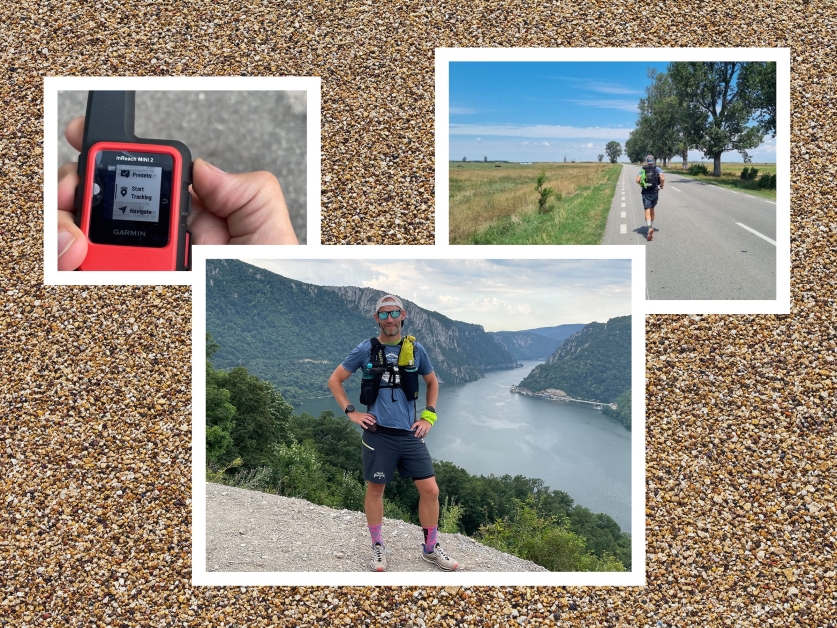If you buy something using links in our stories, we may earn a commission. This helps support our journalism. Learn more. Please also consider subscribing to WIRED
If You’re Hardcore
Garmin inReach Mini 2
If You’re Traveling Abroad
Somewear Labs Global Hotspot
If You’re a Casual Hiker
ACR Bivy Stick
If You’re Old School
Spot X
There was a time when only hardcore off-gridders owned satellite communication devices. Most casual backcountry enthusiasts just didn’t have the necessary budget, or the expertise, to justify an expensive device that spat out weird numbers (latitude, longitude? what?) on a hard-to-read LCD display. We relied on maps and memory to keep us on the right track when wandering off the cellular grid. But that’s all changed thanks to a new crop of more affordable, portable—and much easier-to-use—satellite messengers from brands including Garmin, Zoleo, and even Apple.
Occasional adventurers can now stay in touch while getting wonderfully disconnected. Or be found if the proverbial hits the fan. WIRED’s expert outbackers have trekked to obscure mountain locations, hiked on tree-covered trails, and spent hours getting lost in the wilderness to bring you the pick of the best satellite messengers to pack.
Updated June 2024: We’ve added new designs from Garmin, Zoleo, and Apple and updated entries for Spot, Somewear Labs, and Bivystick.
For more adventure-ready gear, check out our other guides, like the Best Portable Chargers, Best Sleeping Bags, and Best Tents.
Power up with unlimited access to WIRED. Get best-in-class reporting that’s too important to ignore for just $2.50 $1 per month for 1 year. Includes unlimited digital access and exclusive subscriber-only content. Subscribe Today.
If you buy something using links in our stories, we may earn a commission. This helps support our journalism. Learn more. Please also consider subscribing to WIRED
-
Photograph: Kieran Alger
If You’re Hardcore
Garmin inReach Mini 2
If you’ll do anything to save weight in your hyperlite pack, the Garmin inReach Mini 2 is the satellite communicator you need.
This tiny Bluetooth-enabled tracker-communicator is a mere 3.5 ounces and easily stashable. It utilizes the super-fast Iridium satellite network, so you can send a rapid SOS from pretty much anywhere, even the middle of the Indian Ocean.
It boasts essential features like creating waypoints and interval tracking, and it’s great for mapping journeys in real time. I used it to run 1,830 miles across Europe, and it was invaluable for letting my friends and family track my daily progress via a real-time map.
It plays nice with compatible Garmin watches, which I found useful for getting alerts and messages on the wrist. Simple messaging on the device is easy enough, but when you get sick of using an arrow to type your text messages one tedious letter at a time, you can also sync it to your phone to use Garmin’s Earthmate app.
Setup is relatively simple, and it tracks for up to 30 days with 30-minute tracking intervals and standard activity recording with full sky view.
-
Photograph: Somewear Labs
If You’re Traveling Abroad
Somewear Labs Global Hotspot
Somewear’s founders worked at Apple, Tesla, and Intuit (the company that makes Mint and TurboTax), which you can tell by looking at the attractive, easy-to-use device and app (see our full review). Hang the hot spot on your backpack and tether it to your phone to send messages, download maps, or check the forecast via the Iridium network. Its functionality is a little limited—for example, you can text only if your phone is charged and working, and the battery life lasts only for one day of live tracking. This is a great option if you’re off the grid but have access to a power source to recharge both your phone and the device.
Somewear’s founders worked at Apple, Tesla, and Intuit (the company that makes Mint and TurboTax), so it’s no surprise that this spot tracker and app ticks the attractive and easy-to-use boxes (see our full review).
I found it easy to hang the hot spot on my backpack and even simpler to tether it to my phone to send messages, download maps, or check the forecast via the Iridium network.
Without a tethered smartphone, its functionality is a little limited—for example, you can text only when your phone is charged and working, and the battery life lasts only for one day of live tracking. As a result, I found this worked best for heading off the grid when I still had access to a power source to recharge my phone and the device.
But as a compact, easy-to-use safety blanket for shorter adventures, it’s a very solid option. Plus for short-trip weekend warriors, the cheaper subscription plans make boosting safety on mini adventures more affordable.
-
Photograph: ACR
If You’re a Casual Hiker
ACR Bivy Stick
Researching satellite messengers means spending hours trawling often complex subscription plans. But the Iridium-network-powered ACR Bivy Stick removes most of that hassle with its flexible subscription options.
The $20-per-month subscription fee might be a shade high compared to other messengers, but there’s no activation fee, and you can cancel and restart at any time, making this a worthy choice for occasional adventurers.
I found it as convenient to carry as the Garmin inReach Mini 2, and it weighs just 3.35 ounces. But like the Somewear, the Bivy Stick tethers to your phone, so it’s useful only if your smartphone is also alive and kicking. Budget watchers will enjoy that you can purchase credits to text or log your activities via satellite, and any unused creds happily roll over at the end of the month.
The SOS service is excellent—you can send an “I’m OK” message from the device without a tethered smartphone—and if you’re hacking into the wilds as part of a team, there’s off-grid group messaging and location shares.
I enjoyed the fact that this small but solid performer also works as a combination adventure tracker and social media app. You can browse through a 50,000-strong adventure library to find inspiration, see yourself progress from “rookie” to “legend,” and share your accomplishments with your friends.
-
Spot
If You’re Old School
Spot X
The Spot X is the equivalent of that crusty old-timer who hassles you at the trailhead about how your generation is always wearing the wrong shoes. But that guy is sometimes right. The Spot X has somewhat limited coverage with the Globalstar low-Earth-orbit satellite network; you can’t use it to cross an ocean, for example.
It makes you type messages on a stiff, Blackberry-like keyboard, and the Save icon is a floppy disk. But because it’s not tethered to your phone, it will retain all its advanced functionality—two-way texting, mapping, tracking—even when you drop your phone in a lake. You can set its tracking intervals to as little as 2.5 minutes between pings, if you’re speed-hiking or trail running. It’s quite a bit cheaper than the other options (if you need a yearly plan), and it has a great battery life.
-
Photograph: Apple
The One You Already Own
Apple Watch Ultra 2
Before you invest in an emergency satellite messenger, consider this: You might already have one in your pocket or strapped to your wrist. Certain Apple iPhone and Apple Watch models now feature a built-in safety feature—Emergency SOS.
This can connect you to rescue crews even when you’re out of cellular service. The big benefit here is that most of us hit the outback already carrying a charged phone, making this a great safety net.
Emergency SOS via satellite becomes available only when you’re in an area without any Wi-Fi or cellular coverage. Otherwise you’re expected to use regular comms channels to get out of your bind. Ideally, you need a clear view of the sky and the horizon, as obstructions like foliage and mountains can slow or even block your satellite connection. You’ll also need a recent version of Apple’s smartphone, the iPhone 14 or 15, to use Emergency SOS via satellite.
Unlike other, more capable two-way messengers, this service is really only suitable for transmitting key information when you’re in a sticky situation: where you are, what condition you’re in, and what you need help with. But as with most things Apple, that process is made super simple.
To use Emergency SOS via satellite, you first need to try to make an emergency call, like 911. If no networks are available, then the Emergency Text via Satellite option appears onscreen. Tap this, then Report Emergency, and you’ll be prompted to answer a few questions about what’s happened and what sort of assistance you need, before following steps on the phone to send the SOS.
The feature is free for two years when you activate a compatible device. Apple recently announced that it’s giving iPhone 14 owners who previously activated the feature another year of free access.
-
Photograph: Zoleo
For Explorers on a Budget
Zoleo Satellite Messenger
If money is tight, but you don’t want to compromise too much on functionality and features, the Zoleo Satellite Messenger offers a good balance for your bucks.
I found it simple to set up and easy to use, and it offers a good range of mission-critical on-device functions with a welcome boost in capability when you’re tethered to your smartphone.
It primarily uses the Iridium global satellite network but can beam messages to your loved ones back home using cellular coverage or Wi-Fi. There’s basic messaging via the device with enhanced messaging via the app. Or you can fire off preprogrammed SOS and check-in messages—including your location—with just the push of a button. If you and fellow explorers all use the Zoleo app, app-to-app messages via the SMS number bypass roaming charges.
At 5.3 ounces, I found it heftier and harder to stash than the Garmin InReach Mini2 and the Arc Bivy Stick, but there’s good staying power with up to 200 hours when checking messages every 12 minutes. Though unless you’re in a spot of bother, you definitely should be looking at the views.
-
Photograph: Spot
A Basic Tracker
Spot Gen4
If you want a simpler tracker for single-stint adventures, the Spot Gen4 offers reliable one-way comms and location tracking. Functionality here is limited compared to more capable two-way rivals, but there are some neat safety extras, and the staying power is excellent. This beast goes long.
It’s a one-way messenger, so unlike many of the devices on this list, you can only beam simple outbound notes, you can’t receive replies from the folks back home.
In testing, I used the Spot Gen4 for lots of different one-day ultra runs in the European mountain ranges, and it’s great for offering that simple comfort of safety crews knowing where you are at all times.
I love that you can program it to activate tracking when you reach or depart from specific locations, and powering off while you sit still before turning on when you move, is great for sparing vital battery life.
The SOS functions are easy to use, and the Spot Gen4 is fast to send up the metaphorical flares. Plus, there’s a Spot Assist button that’ll notify contacts that you need some help but your struggles are non-life-threatening—let’s say you’ve run out of gas in the desert, for example.
Outbound messaging capabilities include SMS, email, and certain social media platforms, but this needs to be programmed while you’re still in civilization. You can’t do it on the fly sitting on a rock half way up Kilimanjaro.
Unlike most of your outdoor kit—head light, phone, GPS watch—which now use USB charging, the Spot Gen4 runs on AAA batteries. That has pros and cons. The battery life is excellent, and it’s easier to swap in new batteries than it might be to find a power source, but I did find it slightly bothersome carrying extra kit.
-
Photograph: Kieran Alger
How We Test
How We Test
To put our crop of satellite messengers through their paces, I headed off-grid for hikes, rides, runs, and SUPS. I even ran right across Europe (67 marathons in 67 days if you’re wondering). I was looking for the winning combination of simple setup, ease of use (particularly when you’re tired and your head’s gone), pack-friendly portability, long-lasting battery life endurance, and the reliability of the messaging services. I also got the folks back home to report on how easy it was to track my adventures.
-
Goal Zero
Advice and Accessories
Some Tips, Tricks, and Extras
All of our picks are hardy, shockproof, and waterproof—the Spot X is even dustproof. If yours isn’t working, make sure the device is outside and has clear line-of-sight access to the sky. (This will be harder to achieve if you’re under tree cover.) If you’re worried about battery life, we like GoalZero’s light, portable solar panels to charge your devices on the go. If you’d rather go without a subscription plan, and do away with all the navigation and texting features, consider a personal locator beacon instead. It’s initially more expensive, but you won’t have to pay subscription fees.
-
Iridium
Do You Need a Satellite Messenger?
Maybe!
If you never venture too far off the cellular grid, then you probably don’t need a satellite messenger—your smartphone has you covered. But if you’re in the wilderness under certain circumstances, reliable communication could be the difference between life and death—or at least, being really cold, hurt, or hungry. That’s where a satellite messenger comes in.
Which satellite messenger you buy depends on a range of factors including where you’ll be on the planet, its messaging capabilities, durability, and battery life. You might need a different option if you’re tackling multiday mountain climbs versus mixing day-long hikes with chilling in a cabin. Or if you’re exploring in a team rather than solo.
You’ll also need to choose a satellite network. None of these rely on GPS. They use the Iridium and Globalstar low-Earth-orbit satellite networks, which are generally used for communication because they take less energy and have far less lag time than GPS. Globalstar has less coverage (check its maps here).
-
Bivystick
A Note on Pricing Plans
Subscriptions and Fees
It’s worth looking at subscription plans before you pick a device. Don’t be fooled by the cheapest monthly price; both Spot and Garmin offer 12-month contracts, but they come with an activation fee. Monthly “flex” plans are usually a little higher. In general, you can expect most subscription plans to start at $10 to $15 per month. The lowest-tier plans might not include texting or weather forecasts. In general, you’ll want to pick a monthly plan if your adventuring is seasonal, like skiing or summer backpacking; get an annual plan if you live in a remote area or are off the grid year-round.



